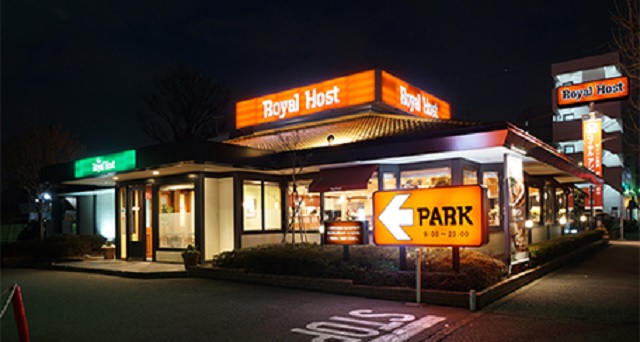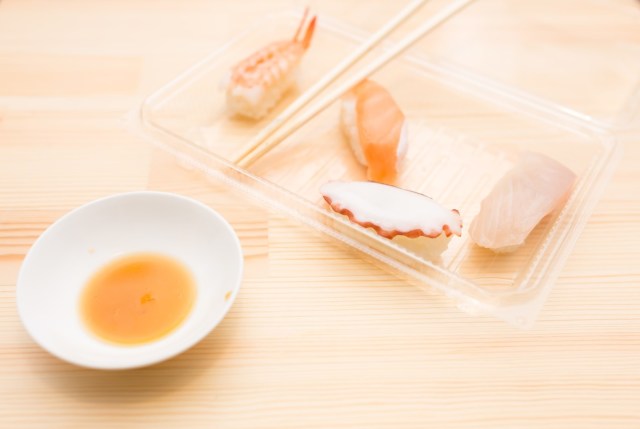
Sustainable development goals cited as reason for change, but there’s probably another factor at play too.
Japanese restaurants have a lot of hospitable touches to them, like the oshibori, a thick, moist hand towel (chilled in the summer, but warm in the winter) and an on-table call button so you can summon a waiter without having to raise your voice. Something they generally don’t have, though, is doggy bags.
Granted, even accounting for differences in the average size of people in Japan and Western nations, Japanese restaurant portions are more modest. That said, there are still Japanese people with particularly small appetites, as well as restaurants in Japan that serve up especially generous portions. But if you don’t clean your plate when eating out in Japan, you can expect any uneaten food to go back into the kitchen when the wait staff clears your table, and then into the trash.
▼ “Not gonna eat me? Fine, then this is goodbye…FOREVER.”
So it actually marked a big policy shift when Royal Host, a popular nationwide restaurant chain specializing in yoshoku (originally Western-style cuisine adapted to suit Japanese tastes) announced that it’s now allowing eat-in customers to take their leftovers home, and is supplying containers for those who wish to do so.
So why don’t all restaurants do this? Some cite health concerns, saying that they don’t want customers to possibly become sick after eating food that wasn’t properly stored or refrigerated between when the customer leaves the restaurant and eventually eats it. This feels like a pretty flimsy excuse, though, given that Japan is filled with convenience stores, bento boxed lunch takeout places, and supermarkets stocked with all manner of pre-made foodstuffs that customers can purchase and take home to eat whenever they want.
▼ This is, after all, a country where every single grocery store is happy to sell you all sorts of take-home sushi made with raw fish.
It’s possible that such businesses may have specialized licenses that restaurants would need to acquire, but even if that is the case, it doesn’t seem like it would be a particularly high hurdle for restaurants to clear, considering that they already need to show they store and handle the food that goes into their dishes in a safe and sanitary manner. So perhaps much of Japanese restaurants’ reluctance to let customers take home their leftovers comes from an image-management position. It’s simply something that restaurants haven’t traditionally done, and customers walking out with bags of food might be seen by some as something that should be left to cheap fast food joints, not sit-down dining establishments.
But whatever the arguments against doggy bags, Royal Host has decided it’s time for a change. In its announcement, the restaurant chain cited a desire to comply with calls from the Japanese government’s Ministry of Agriculture, Forestry, and Fisheries to work towards sustainable development goals by reducing food waste.
The path to Royal Host’s new policy’s implementation was probably further smoothed by the influence the coronavirus pandemic has had on the restaurant industry in Japan. While in-restaurant dining hasn’t been legally prohibited, many Japanese people are choosing to avoid it. In response, a large number of restaurants that previously did not offer take-out, including Royal Host, have started to. So if Royal Host already has containers and is instructing its staff in how to pack up food, it doesn’t seem like it should make a difference if the food being packed is leftovers.
Royal Host’s new policy went into effect on October 7, and while certain items, such as soup and raw foods, are still on the no-take-home list, it’s a big change for the chain, and hopefully one that other restaurants will implement too.
Source: Royal Host via Entabe
Top image: Royal Host
Insert images: Pakutaso (1, 2)
● Want to hear about SoraNews24’s latest articles as soon as they’re published? Follow us on Facebook and Twitter!
Follow Casey on Twitter, where he highly recommends leftover curry.



 Import immediately! The top 3 Japanese chain restaurants
Import immediately! The top 3 Japanese chain restaurants McDonald’s Japan finally bans eat-in dining at over 1,900 locations in Tokyo, elsewhere in Japan
McDonald’s Japan finally bans eat-in dining at over 1,900 locations in Tokyo, elsewhere in Japan Japan’s top 10 best-value family restaurants, as chosen by diners
Japan’s top 10 best-value family restaurants, as chosen by diners Tokyo ramen restaurant bans customers from watching YouTube videos on their phones while eating
Tokyo ramen restaurant bans customers from watching YouTube videos on their phones while eating Vampire Cafe: Over a decade of Tokyo’s best undead dining in Ginza
Vampire Cafe: Over a decade of Tokyo’s best undead dining in Ginza Foreigner’s request for help in Tokyo makes us sad for the state of society
Foreigner’s request for help in Tokyo makes us sad for the state of society Seaside scenery, history, and so many desserts on Yokohama’s Akai Kutsu【Japan Loop Buses】
Seaside scenery, history, and so many desserts on Yokohama’s Akai Kutsu【Japan Loop Buses】 Japanese city loses residents’ personal data, which was on paper being transported on a windy day
Japanese city loses residents’ personal data, which was on paper being transported on a windy day Red light district sushi restaurant in Tokyo shows us just how wrong we were about it
Red light district sushi restaurant in Tokyo shows us just how wrong we were about it McDonald’s new Happy Meals offer up cute and practical Sanrio lifestyle goods
McDonald’s new Happy Meals offer up cute and practical Sanrio lifestyle goods Harajuku Station’s beautiful old wooden building is set to return, with a new complex around it
Harajuku Station’s beautiful old wooden building is set to return, with a new complex around it The 2023 Sanrio character popularity ranking results revealed
The 2023 Sanrio character popularity ranking results revealed Should you add tartar sauce to Japanese curry rice? CoCo Ichi makes diners an unusual offer
Should you add tartar sauce to Japanese curry rice? CoCo Ichi makes diners an unusual offer Starbucks Japan releases new mugs and gifts for Mother’s Day
Starbucks Japan releases new mugs and gifts for Mother’s Day Smash Bros. director Sakurai stabs Kirby in the face, has delicious justification for it
Smash Bros. director Sakurai stabs Kirby in the face, has delicious justification for it Japanese ramen restaurants under pressure from new yen banknotes
Japanese ramen restaurants under pressure from new yen banknotes French Fries Bread in Tokyo’s Shibuya becomes a hit on social media
French Fries Bread in Tokyo’s Shibuya becomes a hit on social media Studio Ghibli releases new action figures featuring Nausicaä of the Valley of the Wind characters
Studio Ghibli releases new action figures featuring Nausicaä of the Valley of the Wind characters New private rooms on Tokaido Shinkansen change the way we travel from Tokyo to Kyoto
New private rooms on Tokaido Shinkansen change the way we travel from Tokyo to Kyoto Tokyo Tsukiji fish market site to be redeveloped with 50,000-seat stadium, hotel, shopping center
Tokyo Tsukiji fish market site to be redeveloped with 50,000-seat stadium, hotel, shopping center Beautiful Ghibli sealing wax kits let you create accessories and elegant letter decorations【Pics】
Beautiful Ghibli sealing wax kits let you create accessories and elegant letter decorations【Pics】 Studio Ghibli releases Kiki’s Delivery Service chocolate cake pouches in Japan
Studio Ghibli releases Kiki’s Delivery Service chocolate cake pouches in Japan New definition of “Japanese whiskey” goes into effect to prevent fakes from fooling overseas buyers
New definition of “Japanese whiskey” goes into effect to prevent fakes from fooling overseas buyers Our Japanese reporter visits Costco in the U.S., finds super American and very Japanese things
Our Japanese reporter visits Costco in the U.S., finds super American and very Japanese things All-you-can-drink Starbucks and amazing views part of Tokyo’s new 170 meter-high sky lounge
All-you-can-drink Starbucks and amazing views part of Tokyo’s new 170 meter-high sky lounge More foreign tourists than ever before in history visited Japan last month
More foreign tourists than ever before in history visited Japan last month New Pokémon cakes let you eat your way through Pikachu and all the Eevee evolutions
New Pokémon cakes let you eat your way through Pikachu and all the Eevee evolutions Disney princesses get official manga makeovers for Manga Princess Cafe opening in Tokyo
Disney princesses get official manga makeovers for Manga Princess Cafe opening in Tokyo Sales of Japan’s most convenient train ticket/shopping payment cards suspended indefinitely
Sales of Japan’s most convenient train ticket/shopping payment cards suspended indefinitely Sold-out Studio Ghibli desktop humidifiers are back so Totoro can help you through the dry season
Sold-out Studio Ghibli desktop humidifiers are back so Totoro can help you through the dry season Japanese government to make first change to romanization spelling rules since the 1950s
Japanese government to make first change to romanization spelling rules since the 1950s Ghibli founders Toshio Suzuki and Hayao Miyazaki contribute to Japanese whisky Totoro label design
Ghibli founders Toshio Suzuki and Hayao Miyazaki contribute to Japanese whisky Totoro label design Doraemon found buried at sea as scene from 1993 anime becomes real life【Photos】
Doraemon found buried at sea as scene from 1993 anime becomes real life【Photos】 Tokyo’s most famous Starbucks is closed
Tokyo’s most famous Starbucks is closed One Piece characters’ nationalities revealed, but fans have mixed opinions
One Piece characters’ nationalities revealed, but fans have mixed opinions We asked a Uniqlo employee what four things we should buy and their suggestions didn’t disappoint
We asked a Uniqlo employee what four things we should buy and their suggestions didn’t disappoint Princesses, fruits, and blacksmiths: Study reveals the 30 most unusual family names in Japan
Princesses, fruits, and blacksmiths: Study reveals the 30 most unusual family names in Japan Miyagi restaurant refuses to accept customers’ money after tsunami warning evacuation
Miyagi restaurant refuses to accept customers’ money after tsunami warning evacuation Sayonara, soy sauce stains! Sushi restaurant worker reveals easy way to deal with spills
Sayonara, soy sauce stains! Sushi restaurant worker reveals easy way to deal with spills Japanese restaurant chain’s solo-diner boxes look depressing, but are actually pretty awesome
Japanese restaurant chain’s solo-diner boxes look depressing, but are actually pretty awesome Tokyo cheerleader pub’s coronavirus countermeasures include full face shields for customers
Tokyo cheerleader pub’s coronavirus countermeasures include full face shields for customers “Is it acceptable to go to a family restaurant for your first date?” Japanese survey asks
“Is it acceptable to go to a family restaurant for your first date?” Japanese survey asks Kyoto restaurant only sells one dish, features mannequins and gets rave reviews!
Kyoto restaurant only sells one dish, features mannequins and gets rave reviews! Chocolate-fed sushi fish set to become a Valentine’s Day treat in Japan
Chocolate-fed sushi fish set to become a Valentine’s Day treat in Japan Family Mart convenience stores will stop offering plastic forks, recommends chopsticks instead
Family Mart convenience stores will stop offering plastic forks, recommends chopsticks instead Flour products sell online for outrageous prices in Japan as demand for them skyrockets
Flour products sell online for outrageous prices in Japan as demand for them skyrockets Beautiful Japanese sightseeing train will be unforgettable way to travel country’s north island
Beautiful Japanese sightseeing train will be unforgettable way to travel country’s north island Eat all of your rice! Culture connections with Japan’s favorite food
Eat all of your rice! Culture connections with Japan’s favorite food Customer discovers portion of human thumb in ramen at noodle restaurant chain in Japan
Customer discovers portion of human thumb in ramen at noodle restaurant chain in Japan A Japanese take on inviting friends over for dinner (and making them pay!)
A Japanese take on inviting friends over for dinner (and making them pay!) Revolving sushi chain Choshimaru’s sushi will no longer revolve in response to “sushi terrorism”
Revolving sushi chain Choshimaru’s sushi will no longer revolve in response to “sushi terrorism”
Leave a Reply